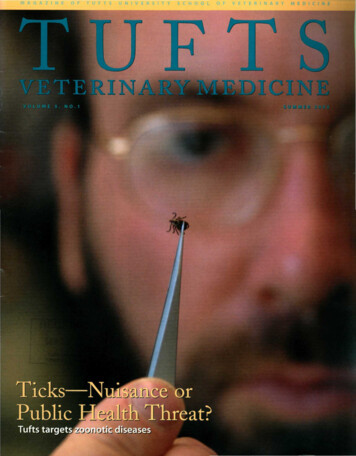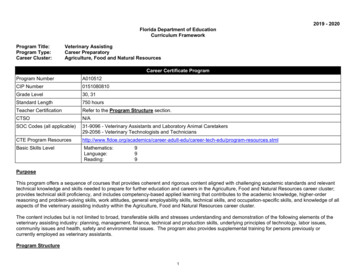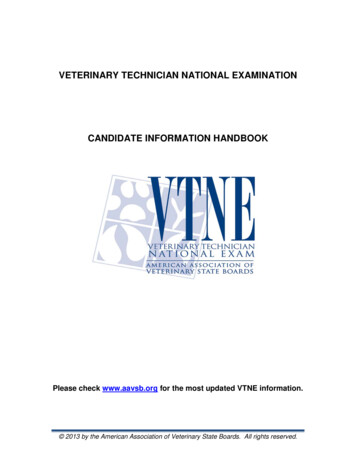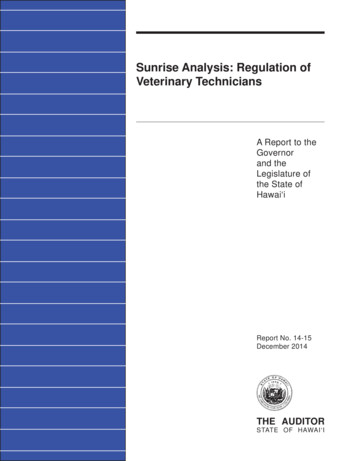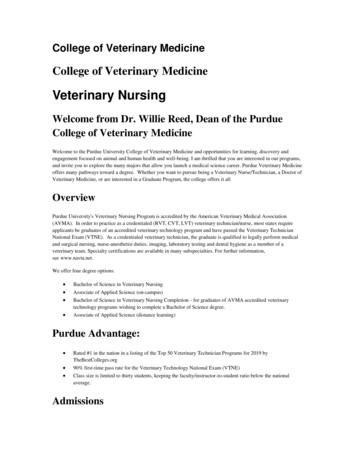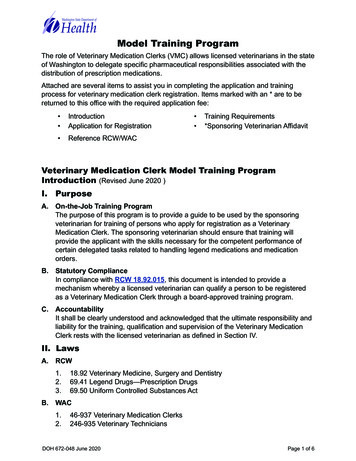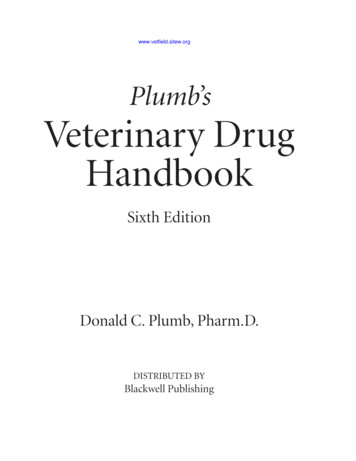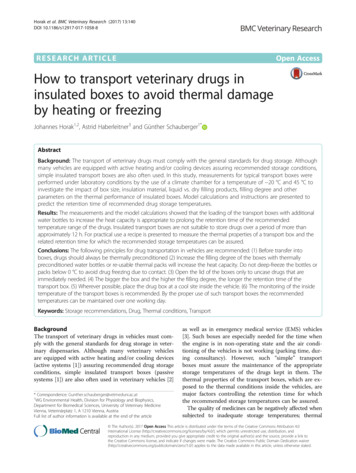
Transcription
Horak et al. BMC Veterinary Research (2017) 13:140DOI 10.1186/s12917-017-1058-8RESEARCH ARTICLEOpen AccessHow to transport veterinary drugs ininsulated boxes to avoid thermal damageby heating or freezingJohannes Horak1,2, Astrid Haberleitner3 and Günther Schauberger1*AbstractBackground: The transport of veterinary drugs must comply with the general standards for drug storage. Althoughmany vehicles are equipped with active heating and/or cooling devices assuring recommended storage conditions,simple insulated transport boxes are also often used. In this study, measurements for typical transport boxes wereperformed under laboratory conditions by the use of a climate chamber for a temperature of 20 C and 45 C toinvestigate the impact of box size, insulation material, liquid vs. dry filling products, filling degree and otherparameters on the thermal performance of insulated boxes. Model calculations and instructions are presented topredict the retention time of recommended drug storage temperatures.Results: The measurements and the model calculations showed that the loading of the transport boxes with additionalwater bottles to increase the heat capacity is appropriate to prolong the retention time of the recommendedtemperature range of the drugs. Insulated transport boxes are not suitable to store drugs over a period of more thanapproximately 12 h. For practical use a recipe is presented to measure the thermal properties of a transport box and therelated retention time for which the recommended storage temperatures can be assured.Conclusions: The following principles for drug transportation in vehicles are recommended: (1) Before transfer intoboxes, drugs should always be thermally preconditioned (2) Increase the filling degree of the boxes with thermallypreconditioned water bottles or re-usable thermal packs will increase the heat capacity. Do not deep-freeze the bottles orpacks below 0 C to avoid drug freezing due to contact. (3) Open the lid of the boxes only to uncase drugs that areimmediately needed. (4) The bigger the box and the higher the filling degree, the longer the retention time of thetransport box. (5) Wherever possible, place the drug box at a cool site inside the vehicle. (6) The monitoring of the insidetemperature of the transport boxes is recommended. By the proper use of such transport boxes the recommendedtemperatures can be maintained over one working day.Keywords: Storage recommendations, Drug, Thermal conditions, TransportBackgroundThe transport of veterinary drugs in vehicles must comply with the general standards for drug storage in veterinary dispensaries. Although many veterinary vehiclesare equipped with active heating and/or cooling devices(active systems [1]) assuring recommended drug storageconditions, simple insulated transport boxes (passivesystems [1]) are also often used in veterinary vehicles [2]* Correspondence: Gunther.schauberger@vetmeduni.ac.at1WG Environmental Health, Division for Physiology and Biophysics,Department for Biomedical Sciences, University of Veterinary MedicineVienna, Veterinärplatz 1, A 1210 Vienna, AustriaFull list of author information is available at the end of the articleas well as in emergency medical service (EMS) vehicles[3]. Such boxes are especially needed for the time whenthe engine is in non-operating state and the air conditioning of the vehicles is not working (parking time, during consultancy). However, such “simple” transportboxes must assure the maintenance of the appropriatestorage temperatures of the drugs kept in them. Thethermal properties of the transport boxes, which are exposed to the thermal conditions inside the vehicles, aremajor factors controlling the retention time for whichthe recommended storage temperatures can be assured.The quality of medicines can be negatively affected whensubjected to inadequate storage temperatures; thermal The Author(s). 2017 Open Access This article is distributed under the terms of the Creative Commons Attribution 4.0International License (http://creativecommons.org/licenses/by/4.0/), which permits unrestricted use, distribution, andreproduction in any medium, provided you give appropriate credit to the original author(s) and the source, provide a link tothe Creative Commons license, and indicate if changes were made. The Creative Commons Public Domain Dedication o/1.0/) applies to the data made available in this article, unless otherwise stated.
Horak et al. BMC Veterinary Research (2017) 13:140degradation and the loss of potency of drugs have been reported following the exceedance of certain temperaturethresholds [4–6]. Küppers et al. [7] recommended thattemperature-sensitive drugs should be replaced after anytemperature stress beyond the limits given by the manufacturers (e.g., 25 C) and that the drugs should be replaced atleast once per year. The inactivation process is described bythe Arrhenius equation: the higher the temperature, thehigher the degradation of active substances [5, 8–10]. Therecommendations distinguish in general between cool (controlled room temperature) and cold storage conditions defined by the ranges 2 C to 25 C and 2 C to 8 C,respectively [11, 12].Beside bags [13], although boxes are used to transportand store temperature-sensitive drugs in veterinary vehicles [2, 3, 14], it often remains unclear whether they areappropriate for this purpose. However, to the knowledgeof the authors, no systematic investigations on the suitability or practicability of passive storage boxes for drugtransport in vehicles have been published so far. Bothexceedance of the upper temperature limit and a shortfall of the temperature to below the lower limit (e.g.,freezing) must be considered. The discrepancy betweenthe thermal needs and requirements to store drugs andthe realities was shown by Haberleitner et al. [2] andOndrak et al. [14] for veterinary vehicles.The dynamic behaviour of the inside temperature of thebox depends on two main features. (1) The heat flow ratethrough the walls of the box depends of the temperaturedifference between inside and outside temperature, theinsulation of the box (wall thickness and thermal conductivity), and the area of the box walls. (2) The heat contentdepends on the mass and the thermal capacity of the filling. The lower the heat flow rate (1) and the higher theheat capacity of the box (2), the slower the change of theinside temperature.In this study, the thermal performance of typical transport boxes were specifically investigated under laboratoryconditions to reveal the impact of box size, insulation material, liquid vs. dry filling products, filling degree and otherparameters. For practical use, a recipe is presented to measure the thermal properties of a transport box and the related retention time for which the recommended storagetemperatures can be assured. With this simple model it canbe assessed whether a certain transport box is appropriateto carry veterinary drugs without exceeding a certainthreshold temperature. The objective of this paper is tocontribute to the quality assurance of veterinary drug storage especially in vehicles.MethodsSix insulated boxes considered typical for drug storageuse in veterinary vehicles were investigated under laboratory conditions.Page 2 of 10Transport boxesThe transport boxes differed in the type of insulation material, volume, surface area, wall thickness, and colour (Table1). With the exception of one box (A), which employed adifferent insulation technique (vacuum plates), theinsulation material was expanded polystyrene with a heatconductivity of λ 0.028 W K 1 m 1, whereas for a vacuuminsulated plate, a value of λ 0.005 W K 1 m 1 was assumed [15]. A vacuum insulated plate consists of an outerlayer of expanded polypropylene foam (EPP) with openingsfor a vacuum insulated panel which is a form of thermalinsulation consisting of a gas-tight enclosure surrounding arigid core, from which the air has been evacuated [15].Figure 1 shows two typical transport boxes used in theexperiments.MeasurementsTo determine the thermal properties of the boxes, thetime courses of the inner temperature of water-filled100 mL bottles, which simulate injection vials, at definedpositions in the box were measured in a heating (45 C) orcooling chamber ( 20 C) to provide a constant ambienttemperature. The contact area of the box to the wall ofthe climate chamber was minimised to prevent heat exchange due to conduction, by the use of point bearings.The temperature was measured at positions P1 to P6 asdepicted in Fig. 2. Measurements were performed using acalibrated Fluke Hydra 2620A with 7 channels in 15 s intervals, with channel 7 recording the ambient temperature.Determination of the thermal properties of the boxesThe time course of the temperature difference TB ΘB ΘA between the inside temperature ΘB (water bottle) andthe ambient temperature ΘA of the heating chamber(ΘA 45 C) or cooling chamber (ΘA 20 C) is given bythe Newton’s law of cooling TB TB , 0 exp( γ t) with thetemperature difference TB,0 for t 0 [16]. The thermal constant γ is given by γ A Um/c and specifies the thermalproperties of the transport box. This factor was used tocharacterise the box and depends on its geometry, the overall coefficient of heat transmission Um (U-value) and theentire heat capacity of its content c (transported drugs).The weighted mean of the overall coefficient of heatTable 1 Properties of the studied transport boxesBox Volume V[dm3]Outside surface area A[m2]Wall thickness 1314
Horak et al. BMC Veterinary Research (2017) 13:140Page 3 of 10Fig. 1 Typical drug transportation boxes. The insulation of box a (left) consists of vacuum plates, and box b (right) is insulated only with polystyrene(EPS). The length of the scale is 33 cmtransmission Um was calculated with U m ¼nPnPAi U i Aii¼1i¼1, where Ui is the coefficient of heat transmission of eachbox wall, and Ai is the corresponding wall surface area. Thecoefficient of heat transmission of a box wall Ui is given by n dPU i ¼ 1 1 αi þ λjj þ 1 αo Þ, where αi (αo) are the coeffij¼0cients of heat transfer between the air inside (outside) thebox and the adjacent surface. The thickness of a materiallayer is given by dj, and its thermal conductivity by λj. Sincethere is almost no forced convection inside the box and inthe heating or cooling chamber, the value of αi and αo canbe assumed to be αi αo 3 W m 2 K 1 [17]. The content’sheat capacity is c mici depending on the mass of thedrugs mi and their heat capacity ci.Following the determination of the time course of thetemperature difference TB during a cooling or heatingprocess, the thermal constant γ was determined by a regression analysis. The temperature was measured at thepositions depicted in Fig. 2, and the thermal constant γiwas determined for each of these positions i. The maximum value of the thermal constant was selected for further analysis to reflect a worst-case scenario.The value of γ was also calculated using the mechanicaland thermal properties given in Table 2. For the calculationof the entire heat capacity of the content (stored drugs) ofthe boxes, two different types of drugs were distinguished:liquid drugs, which show a high specific heat capacity closeto that of water, and dry drugs (e.g., powder, tablets). Fordry drugs, the specific heat capacity was estimated to becd 1100 kJ kg 1 K 1; for liquid drugs (independently if thedrugs are hydrophilic or lipophilic), it was estimated to becl 4000 kJ kg 1 K 1. To increase the heat capacity of theentire box, resulting in a lower thermal constant γ, additional water bottles with a volume of 1000 mL were added.The total heat capacity of a box’s content was calculatedas c md cd ml cl mw cw where md and ml denote themass of dry and liquid drugs (simulated by 100 mL bottles)respectively, and mw the mass of additional 1000 mL waterbottles. The corresponding specific heat capacities areshown in Table 2.Table 2 Mechanical and thermal properties of the materials ofthe insulated boxes and the drugs inside [15–17]Mechanical and thermal propertiesSymbolValueDensity (kg m 3)GlassρG2600AirρA1.2WaterρW1003Specific heat capacity (J K 1 kg 1)GlasscG750AircA1000WatercW4190Drugs (dry) (drugs, blister pack, card)cd 1100Drug (liquid) (drugs, bottle)cl 4000Heat conductivity (W K 1 m 1)Fig. 2 Measurement points inside a transport box. Points P1 to P6denote the 100 mL water-filled bottles (simulating injection vials) inwhich the temperature sensors were placedExpanded polystyrene (EPS)λ0.028Vacuum platesλ0.005αi and αo3.0Heat transfer coefficient (W K 1 m 2)Inside and outside
Horak et al. BMC Veterinary Research (2017) 13:140Page 4 of 10The filling degree F was defined as F c/cmaxwith themaximum heat capacity of a boxcmax Viρwcw. This assumes that the box’s volume Vi is filled entirely withwater (water density ρw 1000 kg m 3, and specific heatcapacity of water cw 4.18 kJ kg 1 K 1). The heat capacity of the air inside a box was neglected. For the measurements inside the climate chamber, the 100 mLbottles as well as the additional 1000 mL water bottleswere preconditioned.Table 4 Comparison of the measured γmeas and the calculatedγcalc thermal constant for the six transport boxes and variousrelative heat capacities, measured in the heating (30 C) and/orcooling ( 10 C) chamberBoxABModel calculationsTwo boxes were modelled (Table 3): box X with a volumeof 27 dm3 (inner dimension 3 3 3 dm3), and box Y witha volume of 54 dm3 (inside dimension 6 3 3 dm3). Thewall thickness is 5 cm, which results in an outside surfacearea of 0.96 m2 and 1.44 m2, respectively. The coefficient ofheat transmission was calculated for expanded polystyrene(EPS) with Um 0.408 W m 2 K 1.For the first calculation, the two boxes, X and Y, werefilled only with three 100 mL bottles (as used for injectables), and in the second calculation, the remaining volume was filled with 1000 mL water bottles, resulting ina total of 24 to 49 bottles for boxes X and Y respectively.The mass of a full 100 mL bottle totals approximately190 g. This yielded a heat capacity of 2.28 kJ K 1 for thetwo boxes filled only with drugs and 102.6 kJ K 1 forbox X and 207.1 kJ K 1 for box Y when filled with additional 1000 mL water bottles (Table 3).ResultsMeasurementsThe measurements in the heating (ΘA 45 C) and cooling chamber (ΘA 20 C) were used to determine thethermal constant γmeas which was then compared to corresponding calculated values γcalc (Table 4). The calculations were carried out with the mechanical and thermalBox propertiesBox XBox YFilling volume V (dm3)2754Surface area A (m2)0.961.44Coefficient of heat transmission Um (W m(U-value) 1K )0.408Only Drugs (three 100 mL water bottles)Heat capacity c (kJ K 1) 12.28Thermal constant γ (h )0.61840.9277Filling degree F (heat capacity) (%)21102.6207.1Thermal constant γ (h )0.01370.0102Filling degree F (heat capacity) (%)9192Drugs and additional water bottlesHeat capacity c (kJ K 1) 1DEFThermal constant γ [h 1]7.20.02560.03407.20.03190.0370Measured γmeasCalculated 20.0800properties (Table 2) of the transport boxes. A comparisonof measured and calculated γ values by a regression analyses showed a high agreement with a coefficient of determination of r2 0.843, which is significant at the 0.001level. The filling degree varied between 4.5% and 17.9%. Amean relative deviation of 22% between γmeas and γcalcwas found which we attribute to geometric factors (e.g.,thermal bridges due to corners, edges and the cover plate).These are not accounted for the chosen model of the coefficient of heat transmission which assumes a plane wall.Model calculationsTable 3 Parameters for the model calculation for the twotransport boxes X and Y 2CFillingdegreeF [%]Model calculations were performed to demonstrate theimpact of box size and their degree of filling on thermalperformance for the two boxes X and Y (Table 3).These calculations were performed for two differentenvironmental conditions: Summer with an ambienttemperature of ΘA 30 C and winter with ΘA 10 C. The retention time, defined as the time periodduring which the storage requirements are fulfilled,was then calculated for the two boxes under the assumption that the box content was thermally preconditioned. For summer calculations it was assumed tohave an initial temperature of 2 C, equal to thelower threshold of cold and cool storage conditions.For winter the corresponding upper thresholds wherechosen yielding initial temperatures of 8 C and 25 Crespectively. The resulting time courses of the drug’s
Horak et al. BMC Veterinary Research (2017) 13:140temperatures are plotted in Fig. 3, for a (A) summerscenario and (B) winter scenario.Retention time calculation and various filling degreesfor the two boxes are summarised in Table 5. Values below12 h were marked in bold to show possible drug storageproblems during a working day. These calculations showthe high impact of the filling degree on retention time, especially for cold storage conditions (2 C and 8 C).Calculations for boxes X and Y also demonstratethe influence of a box’s size. The ratio of surface area(responsible for the heat exchange between box andenvironment) to volume decreases with box size. Forthe same degree of filling F, the retention time isPage 5 of 10greater for the larger box, Y, as compared to thesmaller box, X (Table 5).Due to the fact that Table 5 represents model calculations we added high filling degrees to show the importance of this parameter for the retention time, even ifthese cannot be reached in reality. This demonstratesthat the filling degree F should be as big as possible tomaximise the retention time of a transport box.DiscussionThe proper transport of temperature-sensitive drugs invehicles is a widespread and notorious problem [18–21].For veterinary vehicles a one year field study wasFig. 3 Model calculation of the time course of the inside temperature ΘB of the two virtual boxes X and Y depending on the size and the fillingdegree (heat capacity) of the boxes. The chosen parameters represent a summer (a) and a winter scenario (b) for drugs that must be storedeither in a cool (2 C ΘB 25 C) or cold environment (2 C ΘB 8 C). For the summer scenario, the environmental temperature wasΘA 30 C and the initial temperature ΘB 2 C at t 0 h. For the winter scenario, the environmental temperature was ΘA 10 C, and theinitial temperature (t 0 h), depending on the storage conditions (cool or cold), was ΘB 25 C and ΘB 8 C, respectively
Horak et al. BMC Veterinary Research (2017) 13:140Page 6 of 10Table 5 Retention time (h) of the inside temperature in the recommended temperature range (cool storage conditions 2 C – 25 Cand cold storage conditions 2 C – 8 C) in the insulated boxes X and Y for thermal summer and winter conditions with an ambienttemperature of ΘA 30 C and ΘA 30 C, respectivelyBox XNo of additional 1000 mL water bottles0 112461014152024Heat capacity of the additional water bottles cw (kJ K )0.04.28.416.725.141.858.562.783.6100.3Entire heat capacity c (kJ K 1)2.36.510.619.027.444.160.865.085.9102.6Filling degree F (%)26917243954587691Thermal constant γ (h 0.01640.013765.277.9Retention time of the inside temperature in the recommended range (h)Winter cool 2 C – 25 C1.74.98.114.420.8Winter cold 2 C – 8 C0.71.93.15.57.912.717.518.724.729.5Summer cool 2 C – 25 C2.87.913.023.233.453.974.379.4104.9125.4Summer cold 2 C – 8 C0.41.11.83.24.77.510.411.114.717.533.546.249.3Box YNo of additional 1000 mL water bottles012461020304049Heat capacity of the additional water bottles cw (kJ K 1)0.04.28.416.725.141.883.6125.4167.2204.8Entire heat capacity c (kJ K 1)2.36.510.619.027.444.185.9127.7169.5207.1Filling degree F .04800.02460.01660.01250.0102 1Thermal constant γ (h )Retention time of the inside temperature in the recommended range (h)Winter cool 2 C – 25 C1.23.35.49.613.822.343.564.685.8104.8Winter cold 2 C – 8 C0.41.22.03.65.28.516.524.532.539.7Summer cool 2 C – 25 C1.95.38.715.522.335.970.0104.0138.0168.7Summer cold 2 C – 8 C0.30.71.22.23.15.09.814.619.323.6The drugs and the water bottles were preconditioned for summer and winter conditions at a temperature at the lower (2 C) and upper (8 C or 25 C) limit of therecommended temperature range. Values below a retention time of 12 h were marked in boldpublished recently by Haberleitner et al. [2] showing thatthe drugs are frequently exposed to temperatures notcompliant with recommended storage conditions. Inmany vehicles, drugs are stored in boxes without an active cooling or heating supply. Field measurementsshowed transport temperatures for emergency medicaltechnician (EMS) vehicles far outside of the recommended temperature range, as summarised by Brownet al. [20]. For summer conditions, maximum inner temperatures up to 60 C were determined, and for wintertime, minimum temperatures significantly below thefreezing point [18, 21]. It became evident that either active heating or cooling systems should be used [18, 22]or other efforts made to maintain the recommendedtemperatures when passive storage systems are used.However, to the knowledge of the authors, no systematicinvestigations on the suitability or practicability of passive storage boxes for drug transport in vehicles havebeen published so far.Storage temperatures outside the recommended rangecan affect the quality of drugs [6]. Exceedance of theupper limit of the recommended temperature range maycause a loss of drug quality due to degradationprocesses. The inactivation process is described by theArrhenius equation, the higher the temperature thehigher the degradation of active substances using themean kinetic temperature [5, 8–10]. The mandatoryshelf life of a temperature-sensitive drug allows for adegradation of active substances of less than 5% duringcorrect storage [7, 9, 23]. For a typical drug, an increasein the mean kinetic temperature of 5 C will decreasethe drug’s shelf life by a factor of two [21]. For the USthe storage standards of the US Pharmacopeial Convention are summarised by Brown and Campagna [24].The lower limit of 2 C for the storage temperature wasselected in this study to avoid freezing the drugs, eventhough the freezing point is an individual constant of eachdrug and may differ over a wide range [7]. In particular,injection preparations and vaccines are sensitive to freezing and lose quality and efficacy after thawing. Because“frozen” and “not frozen” distinguish between “(potentially) usable” and “not usable” [7, 12], we selected thislimit of 2 C for pragmatic reasons.To investigate the practicability of insulated boxes forstoring drugs in vehicles, we measured the retention timefor winter conditions and summer conditions with an
Horak et al. BMC Veterinary Research (2017) 13:140experimental ambient temperature of 10 C and 30 C,respectively. The measuring protocol of the World HealthOrganisation [25] for vaccines suggested the ambient temperatures of 5 C and 43 C, respectively. The filling degree of the transport boxes, which describes the heatcapacity load, was defined in a similar way as proposed bythe German [26] and French [27] standards. The measuring points inside the boxes were selected according to theWorld Health Organisation [25], and the most adversemeasuring point was selected for the calculation [28].The results obtained from the experiments were compared with the values of the thermal constant γ obtainedfrom the model calculation (Table 4). The high coefficient of determination r2 showed that the selected exponential model corresponds well with the measured timecourse data for the inner temperature of the box anddemonstrates that the thermal constant of practicallyany transport box can analogously be determined. Thus,the time course and the retention time of any box canbe predicted by its geometry, the thermal properties, andthe heat capacity of the box as determined by the drugsand the additional water bottles.Model calculations were performed for two boxes thatdiffer significantly in size and volume to show the influence of these parameters. The time course of the innertemperature of the two boxes differs only slightly (by theconstant filling degree of the volume) because the dominant factor is the entire heat capacity of a box. By adding1000 mL water bottles, the filling degree F can be increased up to 90%, and the retention time can be increased by a factor of approximately 45 and 80 for box Xand box Y, respectively. This shows the dominant influence of the filling degree on the retention time [25–27].Insulated transport boxes cannot be considered appropriate to store drugs over a period of more than 12 h (Table5). This means that after a “working day”, the content ofthe transport boxes must be stored under appropriateconditions (e.g., transfer into a refrigerator) and thermallypreconditioned according to the recommended temperatures before it is transferred back into the box for the nexttour. A Haberleitner, G Schauberger, J Horak and ISchmerold [2] were able to show that a proper management of the storage of drugs by using solely styrofoamtransport boxes can guarantee the requirements to thethermal storage conditions.The ambient temperature of the transport boxes is theinside temperature of the vehicles being itself predominantly subjected to the outdoor temperature and the radiation balance if no additional heating and cooling (airconditioning) is in operation. As long as the incomingsolar radiation and the outgoing long-wave radiation isnearly balanced, the indoor temperature of the vehiclesis close to the ambient temperature (e.g., during an overcast sky, under a car port, or inside a garage).Page 7 of 10If the radiation balance is dominated by the incomingsolar radiation, the temperature inside the car stabiliseswithin a range between 20 and 35 K above the outsidetemperature [29–36]. Marty et al. [37] found atemperature difference even close to 60 K. As a roughestimation, they assessed the inside temperature due tosolar radiation could reach 30 C for winter time, 60 Cfor spring and autumn and up to 90 C during summertime. The harsh environment inside parked vehicles cancause heat stroke as a life-threatening syndrome observed in human and animals [38, 39] which is documented in the US, by 37 lethal heat stokes by childrenper year (1998–2015) [33, 40].Grundstein et al. [31] developed simple models to calculate the inside steady state temperature of the cabin asa function of the outside air temperature, the irradianceof the solar radiation, and the cloud cover. The dynamicbehaviour of the temperature increase after parking a vehicle in the sun was also measured by several authors[29, 30, 32–34, 36]. A dynamic model for the cabintemperature, which is driven by outside air temperature,solar radiation and wind velocity was presented recently[41]. In most cases, a value close to the maximumtemperature is achieved 20 min after stopping the ventilation. The most effective measure to reduce the insidetemperature is to increase the ventilation by partlyopened windows [32, 34–36]. The protection of the windows by a cover to reduce the incoming solar radiationwas investigated by Jascha and Keck [36] (paper fabricsand tin foil) and Devonshire and Sayer [42] using infrared reflecting foils. They found a reduction up to 11 K[36] and a higher score of thermal comfort [42], compared to the unprotected windows. Veterinary vehiclesshould, therefore, always be parked during daytime(solar radiation) in the shade. The direct exposure of thetransport box to solar radiation through car windowsshould be strictly avoided during summer conditions.The additional heat flow rate could reach up to 1000 W/m2. This additional heat load would reduce the retentiontime of a transport box drastically. Therefore the boxshould be stored also inside the cabin in the shade.The use of passive boxes for drug transportationshould only be a temporary substitute for air conditioning of the cabin to avoid heating as well as freezing. Estimation and knowledge of the thermal properties of theboxes used is a crucial factor for appropriate drug transport in vehicles and an important contribution to qualityassurance in veterinary practice.ConclusionObserving the physical rules governing the thermal performance of passive boxes, the following principles fordrug transportation in vehicles can be recommended:
Horak et al. BMC Veterinary Research (2017) 13:140 Before transfer into boxes, the drugs should always be thermally preconditioned (i) at theupper limit of the recommended temperaturerange for ambient temperatures below therecommended temperature (“winter”) or (ii) atthe lower limit for ambient conditions above therecommended temperature (“summer”). The mostcritical storage condition is the range between2 C and 8 C.Increase the filling degree of the box as much aspossible by thermally preconditioned waterbottles or re-usable thermal packs to increasethe heat capacity of the transport box. Do notdeep-freeze the bottles or packs below 0 C toavoid drug freezing due to contact. This recommendation applies also to active devices (e.g.,refrigerators).Open the lid of the boxes only to uncase neededdrugs. Avoid air exchange especially due to windeffects and due to the thermal rise of the warmerair from inside the boxes during cold outsideconditions.The bigger the box and the higher the fillingdegree, the longer the retention time of thetransport box.Where
insulated plate, a value of λ 0.005 W K 1 m 1 was as-sumed [15]. A vacuum insulated plate consists of an outer layer of expanded polypropylene foam (EPP) with openings for a vacuum insulated panel which is a form of thermal insulation consisting of a gas-tight enclosure surrounding a rigid core, from which the air has been evacuated [15].

